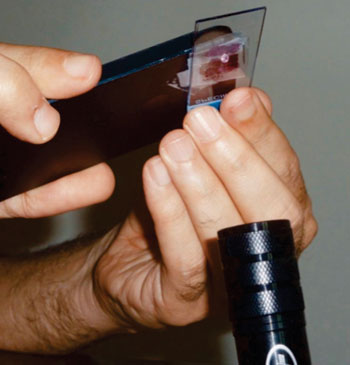Dermatopathology Specimens Examined by Smartphone-Based Microscopy
By LabMedica International staff writers
Posted on 01 Feb 2016
The incorporation of high-resolution cameras into smartphones has allowed for a variety of medical applications including the use of lens attachments that provide telescopic, macroscopic, and dermatoscopic data. Posted on 01 Feb 2016
Skin biopsy and the pathologic information that it provides is foundational to the diagnosis and management of dermatologic disease. However, a lack of expertise in dermatopathologic-specimen interpretation in resource-poor areas may impede timely diagnosis and treatment.

Image: Phone microscopy slide reading: the technique for reading a slide using the ball-lens phone microscope with a single light-emitting diode (LED) flashlight providing illumination (Photo courtesy of University of Texas Houston Health Science).
Pathologists at the University of Texas Houston Health Science Center (TX, USA) and their collaborators constructed a mobile phone microscope by using a modified method and a 3-mm-diameter sapphire ball lens purchased from Edmund Optics (Barrington, NJ, USA). A total of 1,130 consecutive dermatopathology specimens from mostly community dermatologists were evaluated. The performance characteristics of the smartphone platform were calculated by using conventional light microscopy as the gold standard. The sensitivity and specificity for the diagnosis of melanoma, non-melanoma skin cancers, and other miscellaneous conditions by the phone microscopy platform, as compared with traditional light microscopy, were calculated.
All excisional 101 specimens were excluded because the diagnosis was previously established. Among the 1,021 specimens, 930 (91.1%) were shave biopsies and 91 (8.9%) were punch biopsies from 763 different patients. For 136 basal cell carcinoma cases, the sensitivity and specificity of smartphone microscopy were 95.6% and 98.1%, respectively. The sensitivity and specificity for 94 squamous cell carcinoma cases were 89.4% and 97.3%, respectively. The lowest sensitivity was found in the 15 melanomas at 60%, although the specificity was high at 99.1%. The accuracy of diagnosis of inflammatory conditions and other neoplasms was variable.
The authors concluded that their study demonstrated the potential for a high-performing, low-cost smartphone microscopy system in the diagnosis of cutaneous disease. Studies with larger sample sizes of pigmented lesions, non-melanoma skin cancer (NMSC) subtypes, and dermatologic infections could help improve this modality for point-of-care diagnostics in resource-poor settings. The study was published in the January 2016 issue of the journal Archives of Pathology & Laboratory Medicine.
Related Links:
University of Texas Houston Health Science
Edmund Optics














